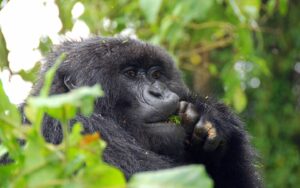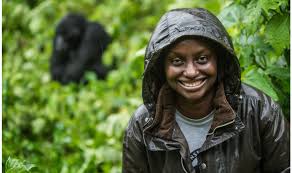About human Gorilla relationship.

Despite the fact gorillas are recorded to be 98% human, gorilla habituation offers more time to human to be close to humans. With such relationship of humans and Gorillas cause various risks like diseases and poaching in their habitants. In 1993, tourism in Uganda opened up for Katendegyere gorilla family which were by then 11 individual and later in 1998, it was affected by poaching and the family remained with 3 individuals.
Dr Gladys being a first veteranian Ugandan doctor says in her memoirs that she treated katendegyere gorilla family with scabies using a dart pistol and blowpipe. She added saying that she used to administered doses of ivermection to the gorillas that were losing hair and developing white scaly skin. Dr Gladys Zikusoka continuously said that gorillas got these infections from exposed to various things like
- when they left the forest to forage for banana plants, and bark of eucalyptus trees on community lands.
- Where people putout dirty clothing to scare away wild animals including gorillas, baboons, and birds.
In her memoirs titled walking with Gorillas, she writes curiously knowing that gorillas touched clothings from infected humans and the mites burrowed under their skin thus the mites spread to the entire family when the gorillas groomed each other.
About Dr Gladys Zikusoka
Dr Gladys was born on 8th January 1970 at Mulago Hospital in Kampala to Rhoda and William Wilberforce Kalema. She grew up surrounded by pets thus the love and passion of being a veteranian doctor. She attended Kabale preparatory school in kabale district. Kings College Budo in O’level in Kampala, Dollar Academy in Scontland, and Kibuli Secondary School for A’level in Kampala. With all her education, she was determined to be a veterinary.
While at the University, Dr Gladys graduated as a veteranian at Royal Veterinary College in the University of London. After her studies, she returned to Uganda as the first veteranian who worked with Uganda national parks. She was later rebranded by Uganda Wildlife Authority however in the process of working with UWA, she setted up Veterinary department.
27 years and counting.

Dr Gladys as soon as she finished education didn’t know that she will dedicate her 27 years and counting on treating sick animals in the wild, relocating wandering elephants, giraffes and gorillas, reintroducing giraffes, rescuing orphaned chimpanzees, rescuing animals from snares and testing cape for zoonotic diseases.
She said that Zoonotic diseases are transmitted from animals to humans however can be vise versa. The Gorillas are put at risk by common diseases like cholera and Typhoid through defecating the gardens. she added saying that very few understand that people and animals can make each other sick and that in turn, this can have enormous impacts on conservation, public health, and sustainable development. While at CTPH, she added saying that her and the team have developed a multidisciplinary approach to address these issues but it didn’t fit into a neat category. It was difficult for donors and policy makers to understand the potential benefits.
Pre covid-19
Together with the lab-leak hypocrites, a zoonotic episode is hypothesized as a potential trigger of the Covid-19 pandemic. Dr Glays revealed that covid-19 brought the CTPH concept to a broader acceptance, but wildlife veterinarians have been grappling with the reality of zoonotic disease outbreaks between people and wildlife for as long as there have been wildlife veterinarians.
Between the health human, animals and environment, there is a global effort known as one health that aims to help people to better understanding and responding to the intricate connections. By the time the US centers for Diseases, Control and Prevention (CDC) established its one Health Office, conservation, through public Health had been implementing the approach for six years however it became into maturity during covid-19 pandemic.
Due to pandemic threats, Uganda is also processing to develop a national one health platform to work together to prevent. detect and respond to existing zoonotic diseases.
Dr Gladys work is not only recognized by the greatest conservation organizations but also she was rewarded at Jane Goodall Institute Award for conservation. Due to her strong bond with gorillas, the loss of one of them left a scar in her.
About Dr Glady’s love for Kanyonyi gorilla.
Dr Gladys said that when she was about to launch the gorilla conservation café in 2017 December and she received shocking news about the death of kanyonyi gorilla who she has known it since it was a baby and the coffee has been named it. Unfortunately, kanyonyi died after. She added saying that kanyonyi gorilla has been one of her favorite gorilla however has been taken over the leadership of mubare gorilla group from his father Ruhondeza five years earlier.
Dr Gladys continuously said that kanyonyi had fallen off a tree and developed an infection in his hip. She treated it with antibiotics, but he would fight with a habituated lone silverback, Maraya and never fully recovered
She later revealed more about kanyonyi saying that he had grown up around tourists as a silverback and leader of his gorilla family. She added saying that kanyonyi used to come out deliberately to frighten tourists to see their reaction. Due to its humour idea which was definitely lost on the unspecting tourists.







